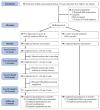Efficacy of Digital Dance on Brain Imagery, Cognition, and Health: Randomized Controlled Trial
- PMID: 39078687
- PMCID: PMC11322681
- DOI: 10.2196/57694
Efficacy of Digital Dance on Brain Imagery, Cognition, and Health: Randomized Controlled Trial
Abstract
Background: Multidomain interventions have demonstrable benefits for promoting healthy aging, but self-empowerment strategies to sustain long-term gains remain elusive.
Objective: This study evaluated the effects of digital somatosensory dance game participation on brain imagery changes as primary outcomes and other physical and mental health measures as secondary outcomes related to healthy aging.
Methods: Between August 31, 2020, and June 27, 2021, this randomized controlled trial recruited 60 eligible participants older than 55 years with no recent engagement in digital dance games. A computer-generated randomization sequence was used to allocate participants 1:1, without stratification, to an intervention group (n=30) who underwent digital somatosensory dance game training or a control group (n=30). An anonymized code masked the intervention allocations from the investigators, and individuals who assigned the interventions were not involved in analyzing the study data. The intervention entailed two 30-minute dance game sessions per week for 6 months, and the control group received healthy aging education. Primary outcomes were brain imagery changes. All variables were measured at baseline and the 6-month follow-up, and intervention effects were estimated using t tests with intention-to-treat analyses.
Results: Compared with the control group, intervention participants had significantly different brain imagery in the gray matter volume (GMV) of the left putamen (estimate 0.016, 95% CI 0.008 to 0.024; P<.001), GMV of the left pallidum (estimate 0.02, 95% CI 0.006 to 0.034; P=.004), and fractional amplitude of low frequency fluctuations of the left pallidum (estimate 0.262, 95% CI 0.084 to 0.439; P=.004). Additionally, the intervention group had different imagery in the cerebellum VI GMV (estimate 0.011, 95% CI 0.003 to 0.02; P=.01). The intervention group also had improved total Montreal Cognitive Assessment scores (estimate 1.2, 95% CI 0.27 to -2.13; P<.01), quality of life (estimate 7.08, 95% CI 2.35 to 11.82; P=.004), and time spent sitting on weekdays (estimate -1.96, 95% CI -3.33 to -0.60; P=.005). Furthermore, dance performance was significantly associated with cognitive performance (P=.003), health status (P=.14), resilience (P=.007), and demoralization (P<.001).
Conclusions: Digital somatosensory dance game participation for 6 months was associated with brain imagery changes in multiple regions involving somatosensory, motor, visual, and attention functions, which were consistent with phenotypic improvements associated with healthy aging.
Trial registration: ClinicalTrials.gov NCT05411042; https://clinicaltrials.gov/study/NCT05411042.
Keywords: RCT; aged; ageing; aging; brain; cognition; cognitive; cognitive performance; controlled trial; controlled trials; dance; dancer; dancing; demoralization; digital; elder; elderly; game; games; gaming; geriatric; geriatrics; gerontology; image; imagery; imaging; movement; neuroscience; older adult; older adults; older people; older person; physical function; quality of life; randomized; resilience; somatosensory; somatosensory dance; somatosensory game; sport; sports.
©Heng-Hsin Tung, Chen-Yuan Kuo, Pei-Lin Lee, Chih-Wen Chang, Kun-Hsien Chou, Ching-Po Lin, Liang-Kung Chen. Originally published in the Journal of Medical Internet Research (https://www.jmir.org), 30.07.2024.
Conflict of interest statement
Conflicts of Interest: None declared.
Figures


References
-
- World report on ageing and health. World Health Organization. 2015. Sep 29, [2024-07-11]. https://www.who.int/publications-detail-redirect/9789241565042 .
-
- WHO's work on the UN Decade of Healthy Ageing (2021-2030) World Health Organization. [2024-07-11]. https://www.who.int/initiatives/decade-of-healthy-ageing .
-
- Chen L, Hwang A, Lee W, Peng L, Lin M, Neil DL, Shih S, Loh C, Chiou S, Taiwan Health Promotion Intervention Study for Elders research group Efficacy of multidomain interventions to improve physical frailty, depression and cognition: data from cluster-randomized controlled trials. J Cachexia Sarcopenia Muscle. 2020 Jun;11(3):650–662. doi: 10.1002/jcsm.12534. - DOI - PMC - PubMed
-
- Lee W, Peng L, Lin C, Chen R, Lin S, Loh C, Kao S, Hung T, Chang C, Huang C, Tang T, Huang S, Wen Y, Hsiao F, Chen L, Lin H, Lin M, Chou M, Liang C, Lin C, Liu L, Hwang A. Effects of incorporating multidomain interventions into integrated primary care on quality of life: a randomised controlled trial. The Lancet Healthy Longevity. 2021 Nov;2(11):e712–e723. doi: 10.1016/s2666-7568(21)00248-8. - DOI - PubMed
-
- Adcock M, Sonder F, Schättin A, Gennaro F, de Bruin ED. A usability study of a multicomponent video game-based training for older adults. Eur Rev Aging Phys Act. 2020;17:3. doi: 10.1186/s11556-019-0233-2. https://eurapa.biomedcentral.com/articles/10.1186/s11556-019-0233-2 233 - DOI - DOI - PMC - PubMed
Publication types
MeSH terms
Associated data
LinkOut - more resources
Full Text Sources
Medical
Miscellaneous

